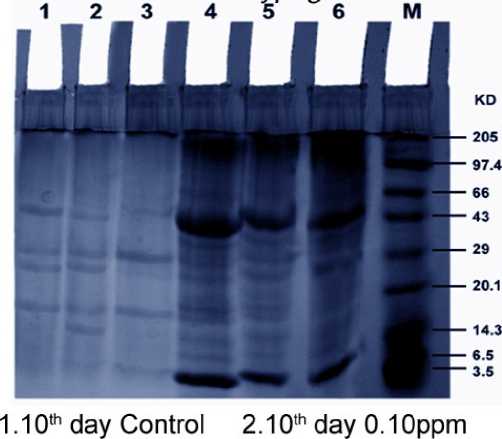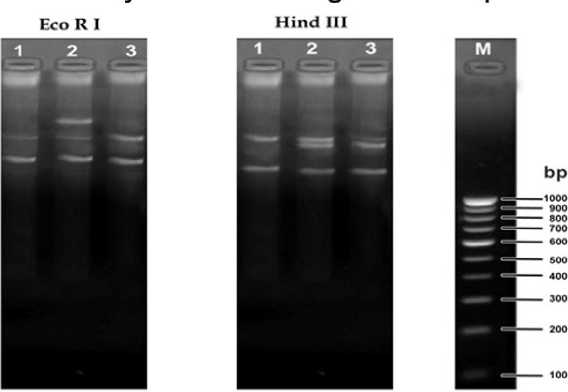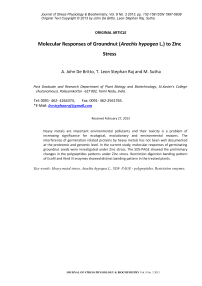Molecular responses of groundnut ( Arachis hypogea L.) to zinc stress
Автор: John De britto A., Leon Stephan raj T., Sutha M.
Журнал: Журнал стресс-физиологии и биохимии @jspb
Статья в выпуске: 3 т.9, 2013 года.
Бесплатный доступ
Heavy metals are important environmental pollutants and their toxicity is a problem of increasing significance for ecological, evolutionary and environmental reasons. The interference of germination related proteins by heavy metals has not been well documented at the proteomic and genomic level. In the current study, molecular responses of germinating groundnut seeds were investigated under Zinc stress. The SDS-PAGE showed the preliminary changes in the polypeptides patterns under Zinc stress. Restriction digestion banding pattern of EcoRI and Hind III enzymes showed distinct banding pattern in the treated plants.
Heavy metal stress, arachis hypogea l, sds- page - polypeptides, restriction enzymes
Короткий адрес: https://sciup.org/14323761
IDR: 14323761
Текст научной статьи Molecular responses of groundnut ( Arachis hypogea L.) to zinc stress
The effect of environmental stresses on plants has been one of the main interests in modern biological research. This is connected with radical ecological changes and reduction in biodiversity Changes driven by ecological stresses can be investigated at molecular and other hierarchical levels. Such stresses as drought, salt, cold, heat, chemical pollutants, heavy metals and others, frequently act together and trigger adaptive and protective mechanisms (Vinocur and Altman, 2005) Heavy metals represent both essential components for the maintenance of normal biological functions and toxic agents with damaging consequences when present in inappropriate amounts. Metals such as copper and zinc play important roles as cofactors for normal enzyme functioning, and zinc contributes to the structural elements of some transcription factors. Excessive concentrations of trace elements (Cd, Co, Cr, Hg, Mn, Ni, Pb and Zn) are toxic and lead to growth inhibition, decrease in biomass and death of the plant (Zenk, 1996). Plants exposed to high levels of heavy metals typically accumulate the metals in their tissues, often to toxic levels that decrease growth or reproduction.
The mechanisms utilized by plants to protect cells from excess heavy metals are not completely understood, but are known to include internal and eternal chelators, efflux pumping, vacuolar compartmentalization, and heat-shock proteins (Cobbett, 2000).
A general response of plants to elevated levels of heavy metals appears to be increased synthesis of various heat-shock proteins (Hsps) (Barque et al., 1996; Wollgiehn and Neumann, 1999). However, the specific cell components or processes targeted by Hsps during metal stress are not yet identified. The genome (DNA) is stable through many stress, the transcriptome (mRNA population) and proteome (protein population) change during development, under biotic and abiotic stress, sometimes rapidly and dramatically (Rampitsch and Srinivasan, 2006). Present investigation was carried out to understand the Zinc stress mediated molecular response in groundnut ( Arachis hypogea L.), an important legume food crop of India grown on about 8 million ha of land.
MATERIALS AND METHODS
Plant material and stress treatment
The groundnut seeds (Nadu) were collected from seed testing centre , Tirunelveli and soaked with water for 24 hrs. Ten pre-soaked seeds were sown in trays filled with equal amount of garden soil and sandy soil and treated with aqueous solution of different concentrations Zinc (0.10 ppm and 0.15 ppm conc.) at regular interval. Distilled water was used in case of control. The Zinc treated germinated plant materials were collected on 10th and 20th day for analysis.
Isolation of protein
The isolation of protein was done as per Lowry et al. (1951) and separated in 10% Sodium Dodecyl
Sulphate – Polyacrylamide Gel Electrophoresis (SDS-PAGE) following the procedure given by Lammelli (1970).
DNA Isolation
Genomic DNA was isolated form the young leaves of the stressed plants as per standard protocol of Doyle and Doyle (1987) and quantified as per Sambrook and Russell (2000).
Restriction Enzyme Digestion
Restriction digestion performed by two restriction enzymes Eco R I and Hind III. The restriction digestion mixture was prepared by sterile double distilled water (13 µl), 10X restriction buffer (2 µl), DNA sample (3 µl) and restriction enzyme (2 µl) in a micro centrifuge tube. The mixture was gently mixed by repeated pipetting or tapping and incubated at 370 C. The reaction was stopped by incubating the mixture at 600 C for 2 minutes. The reaction product was checked in the Agarose Gel (1%) Electrophoresis.
Determination of Molecular Weight
The molecular weight of the protein and DNA was compared by standard molecular ruler Standard proteins with molecular weights of 205.0, 97.4, 66.0, 43.0, 29.0, 20.1, 14.8, 6.5, 3.5 and 2.8 kilo Dalton (kDa) were used as markers. 100 base pairs (bp) molecular marker was used as DNA standard ruler.
RESULTS AND DISCUSSION
Protein Profile
Totally 17 bands (Figure 1) were observed on 10th day of Zinc stress. The control had five bands with molecular weight ranging from 112.0 to 3.5 kDa. Plants treated with 0.10 ppm and 0.15 ppm Zinc showed seven and five banding patterns ranging from 39.8 to 2.8 and 35.8 to 2.8 kDa respectively (Table 1). On 10th day concentration, five new bands (39.8, 28.2, 8.0, 5.1 and 2.8 kDa) were observed in 0.10 ppm and four new bands (39.8, 28.2, 8.0 and 2.8 kDa) were observed from 0.15 ppm. In 0.10 ppm the number of bands was slightly increased and their molecular weight also differed from control. Same type of new protein bands were observed in 0.15 ppm.
On the 20th day, eleven bands were reported in control and their molecular weight varied from 112.0 to 2.0 kDa. At 0.10 ppm and 0.15 ppm Zn concentrations, ten and eight banding patterns ranging from 28.0 to 2.9 and 56.2 to 4.0 kDa were reported. On 20th day, three new bands (28.0, 11.0 and 8.0 kDa) were observed in 0.10 ppm Zn treatment so also three new protein bands (56.2, 11.0 and 8.0 kDa) were observed in case of 0.15 ppm Zn treatment (Figure. 1).
Several classes of Heat Shock Proteins (HSP) have been described in plants, among them HSP110kDa, HSP90kDa, HSP70kDa HSP60kDa and low molecular weight HSPs (Vierling, 1991). Similar types of proteins were observed in the stressed conditions in our study. The main function of such HSPs is to alter the conformation or assembly of other protein structure.
Through genetic analysis and cellular biological research it became clear that the major stress proteins were acting as molecular chaperones in a variety of cellular systems. It now seems that virtually all the major families of stress proteins act as molecular chaperones in at least one system. Molecular chaperons are key components contributing to cellular homeostasis in cells under stress conditions. They are responsible for the protein folding, assembly, translocation and degradation (Knight and Ackerly, 2001). It is well known that members of HSP70kDa family are mainly localised in cytoplasm, where both stress- induced and constitutive polypeptides are expressed (Bukau and Horwich, 1998; Morimoto, 1998).

3.10th day 0.15ppm 4. 20th day Control5. 20th day O.IOppm 5. 20th day 0.15ppm M. Molecular Weight Marker.
-
Figure 1. Effect of Zinc on protein in Arachis hypogea L

1. Control, 2. О.Юррт, 3. 0.15ppm
-
Figure 2. Restriction digestion banding pattern on 20th day zinc treated groundnat plant
Table 1. Molecular weight of Proteins in Arachis hypogeae L. under Zinc stress
|
Band Number |
1Oth DAY |
2Oth DAY |
Molecular Marker (Lane 7) |
||||
|
Control (Lane 1) |
0.10ppm (Lane 2) |
0.15ppm (Lane 3) |
Control (Lane 4) |
0.10ppm (Lane 5) |
0.15ppm (Lane 6) |
||
|
1 |
+ |
- |
- |
+ |
- |
- |
205.0 |
|
2 |
- |
- |
- |
- |
- |
97.4 |
|
|
3 |
+ |
66.0 |
|||||
|
4 |
- |
- |
- |
- |
- |
+ |
|
|
5 |
- |
+ |
+ |
+ |
- |
- |
43.0 |
|
6 |
- |
+ |
+ |
- |
+ |
29.0 |
|
|
7 |
- |
- |
- |
+ |
- |
||
|
8 |
+ |
+ |
- |
+ |
+ |
+ |
20.0 |
|
9 |
+ |
+ |
- |
+ |
+ |
+ |
14.3 |
|
10 |
- |
- |
- |
- |
+ |
+ |
- |
|
11 |
- |
- |
- |
+ |
+ |
- |
- |
|
12 |
+ |
- |
- |
+ |
+ |
- |
- |
|
13 |
- |
+ |
+ |
+ |
+ |
+ |
- |
|
14 |
- |
+ |
- |
+ |
+ |
+ |
6.5 |
|
15 |
+ |
- |
+ |
+ |
+ |
+ |
3.5 |
|
16 |
- |
+ |
+ |
+ |
+ |
- |
2.8 |
Table 2. DNA banding pattern of EcoRI and Hind III digestion in Zinc Treated 20th day Arachis hypogea L .
|
Band No. |
EcoRI |
Hind III |
||||
|
Control (Lane-1) bp |
0.10ppm (Lane-2) bp |
0.15ppm (Lane-3) bp |
Control (Lane-1) bp |
0.10ppm (Lane-2) bp |
0.15ppm (Lane-3) bp |
|
|
1. |
- |
1784.6 |
- |
- |
- |
- |
|
2. |
1778.2 |
1778.2 |
1778.2 |
1778.2 |
1778.2 |
1778.2 |
|
3. |
- |
- |
- |
- |
- |
1757.3 |
|
4. |
- |
1428.4 |
- |
- |
1603.6 |
- |
|
5. |
1380.6 |
- |
1380.6 |
- |
- |
- |
|
6. |
- |
- |
- |
1258.4 |
1258.4 |
- |
|
7. |
- |
- |
- |
- |
- |
- |
|
8. |
- |
- |
- |
- |
- |
- |
|
9. |
- |
- |
- |
- |
- |
1174.3 |
Restriction Analysis
Usually restriction enzymes recognize only the recognition sites. If the DNA is affected due to stresses the recognition sequences also are affected or altered and it will be reflected in the banding pattern when such restriction enzymes are used. In our investigation, we used two restriction enzymes EcoRI and HindIII both in the control and the treated DNA of 20th day groundnut sample and compared the banding pattern. The molecular weight of the control plant differed from treated plant (Figure 2) proving that in treated plants the DNA sequences have been altered by Zn stress. It was reported that Zn ions were shown to inhibit DNA fragmentation and apoptosis induced by various stimuli in different systems (Ciesieslska et al ., 2000; Cai and Cherian, 2003).
CONCLUSION
The present study shows that, although zinc metal is essential for normal plant growth and physiological processes, above threshold concentrations the metal is toxic and may result in growth inhibition and altered metabolic processes in groundnut. The Heat Shock Proteins and chaperones are synthesized in response to Zn stress in ground nut plants. It is important that ground nut crop should be protected from such heavy metal stress and measures should be taken to reduce Zn stress.
Список литературы Molecular responses of groundnut ( Arachis hypogea L.) to zinc stress
- Barque, J. P., Abahamid, A., Chacun, H. and Bonaly, J. (1996) Different heat-shock proteins are constitutively overexpressed in cadmium and pentachlorophenol adapted Euglena gracilis cells. Biochemical and Biophysical Research Communications 223: 7-11.
- Bukau, B. A. and Horwich, A. L. (1998) The Hsp 70 and Hsp 60 chaperone machines. Cell, 92: 351-366.
- Cai, L. and Cherian, G. (2003) Zinc-metallothionein protects from DNA damage induced by radiation better than glutathione and Cu-or Cd-metallothioneins. Toxicol Lett., 136: 193-198.
- Ciesieslska, A. S., Stachura, A., Sbotwinska, M., Kamibska, T., Sniezka, R., Paduch, R., Abramczyk, D., Filar, J. and Szerszen, M. K. (2000) The inhibitory effect of zinc on cadmium-induced cell apoptosis and Reactive Oxygen Species (ROS) production in cell cultures. Toxicology, 145: 159-171.
- Cobbett, C. S. (2000) Phytochelatins and their roles in heavy metal detoxification. Plant Physiology, 123: 825-832.
- Doyle, J. J. and Doyle, J. L. (1987) A rapid DNA isolation procedure for small quantities of fresh leaf tissue. Phytochem. Bull., 19: 11-15.
- Knight Ch, A. S. and Ackerly, D. D. (2001) Correlated evolution of chloroplast heat shock protein expression in closely related plant species. Amer. J. Botany., 88: 411-418.
- Lammelli, U. K. (1970) Cleavage of structural proteins. during the assembly of the head of the bacteriophage T4. Nature, 227: 680.
- Lowry, O. H., Rose Brough, Fan, N. J. and Randall, R. J. (1951) Protein measurement with the Folin-phenol reagent. J. Bio. Chem., 193: 265-272.
- Morimoto, R. I. (1998) Regulation of the heat shock transcriptional response: cross talk between a family of heat shock factors, molecular chaperones and negative regulators. Genes. Dev., 12: 3788-3796.
- Rampitsch Ch and Srinivasan, M. (2006) The application of proteomics to plant biology: a review. Can. J.Bot., 4: 883-892.
- Sambrook and Russell. (2000) Molecular cloning: A laboratory manual. Third Edition.Vol 1. Cold Spring Harbors Laboratory Press, Cold Spring Harbor, New York, USA.
- Vierling, E. (1991) The roles of heat shock proteins in plants. Ann. Rev. Plant Physiol. Plant Mol. Biol., 32: 579-620.
- Vinocur, B. and Altman, A. (2005) Recent advances in engineering plant tolerance to abiotic stress: achievements and limitation. Current Opinion in Biotechnology, 6: 123-132.
- Wollgiehn, R. and Neumann, D. (1999) Metal stress response and tolerance of cultured cells from Silene vulgaris and Lycopersicon peruvian-um: role of heat stress proteins. Journal of Plant Physiology, 154: 547-553.
- Zenk, M. H. (1996) Heavy metal detoxification in higher plants-a review. Gene, 179: 21.


